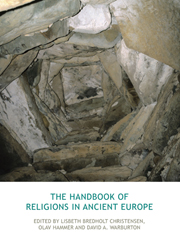Book contents
- Frontmatter
- Contents
- A note on Greek and Latin sources
- Abbreviations and short titles
- 1 Introduction
- PART I PREHISTORIC RELIGIONS
- PART II ANCIENT EUROPE IN THE HISTORICAL PERIOD
- 12 Minoan and Mycenaean religion
- 13 Etruscan religion
- 14 The religions of the Iberian Peninsula
- 15 Italic religion
- 16 Roman religion
- 17 Ancient Greek religion
- 18 The Graeco-Roman cult of Isis
- 19 The cult of Mithras
- 20 Religious Platonism: philosophy and religion in the Platonic tradition
- 21 Insular Celtic religion
- 22 Continental Germanic religion
- 23 Pre-Christian Anglo-Saxon religion
- 24 Old Norse religion
- 25 Slavic religion
- 26 Baltic religion
- 27 Religion in prehistoric Finland
- 28 Sami religion
- Timeline of key dates
- Contributors
- References
- Index
24 - Old Norse religion
from PART II - ANCIENT EUROPE IN THE HISTORICAL PERIOD
- Frontmatter
- Contents
- A note on Greek and Latin sources
- Abbreviations and short titles
- 1 Introduction
- PART I PREHISTORIC RELIGIONS
- PART II ANCIENT EUROPE IN THE HISTORICAL PERIOD
- 12 Minoan and Mycenaean religion
- 13 Etruscan religion
- 14 The religions of the Iberian Peninsula
- 15 Italic religion
- 16 Roman religion
- 17 Ancient Greek religion
- 18 The Graeco-Roman cult of Isis
- 19 The cult of Mithras
- 20 Religious Platonism: philosophy and religion in the Platonic tradition
- 21 Insular Celtic religion
- 22 Continental Germanic religion
- 23 Pre-Christian Anglo-Saxon religion
- 24 Old Norse religion
- 25 Slavic religion
- 26 Baltic religion
- 27 Religion in prehistoric Finland
- 28 Sami religion
- Timeline of key dates
- Contributors
- References
- Index
Summary
PRELIMINARY REMARKS
Before 1000 CE the written sources documenting the pre-Christian religion of Scandinavia are few and meagre. Nevertheless, Roman texts like those of Tacitus (Germania 3.9.40) and Pliny the elder (Naturalis Historia [Natural History] 4.97) contain passages describing gods, rites and ceremonies of the far north. Archaeological findings of graves, burnt offerings in the graves, sacrificial places, figurines and other items corroborate these sources and add to our knowledge (Schjødt 1986: 180–96). To this can be added the information provided by younger source material such as the Eddic poems and Snorri Sturlusson's chronicles, his Edda and Heimskringla, written in the thirteenth century (Turville-Petre 1964: 1–34; Clunies Ross 1994: 20–31).
THE WRITTEN SOURCES
One of the oldest written sources is the Gesta danorum (History of the Danes), the work of the Danish monk Saxo called Grammaticus, written in the twelfth century. The first eight books of Saxo's History of the Danes are built on pre-Christian material. Other sources which document Old Norse mythology are the Edda and Heimskringla, the work of the Icelandic writer Snorri Sturluson (d. 1241). The Poetic Edda is an anonymous collection of poems about gods and heroes, among them Völuspá “the Prophecy of the Seeress”, Hávamál “Sayings of the High One” and Prymskviða “Þrym's poem”.
The family sagas or Fornalðarsögur were composed by Christian authors and give only glimpses of pre-Christian times. They are filled with mythical figures, but are more recent and sometimes unreliable. Most of these accounts date back to thirteenth-fourteenth-century Iceland.
- Type
- Chapter
- Information
- The Handbook of Religions in Ancient Europe , pp. 324 - 337Publisher: Acumen PublishingPrint publication year: 2013



